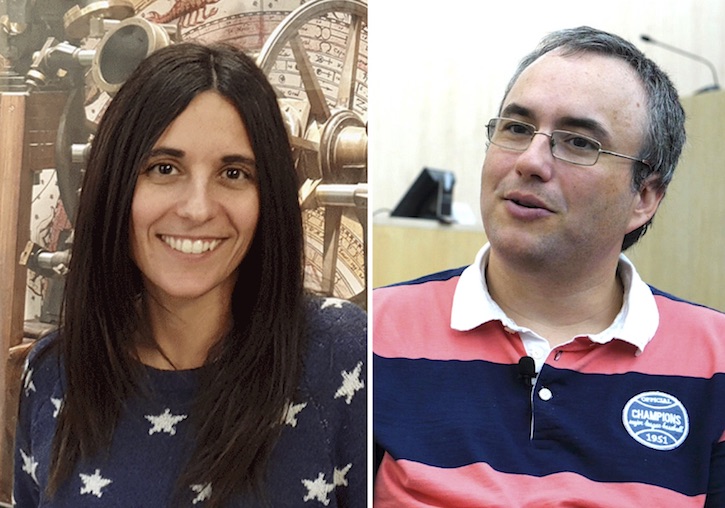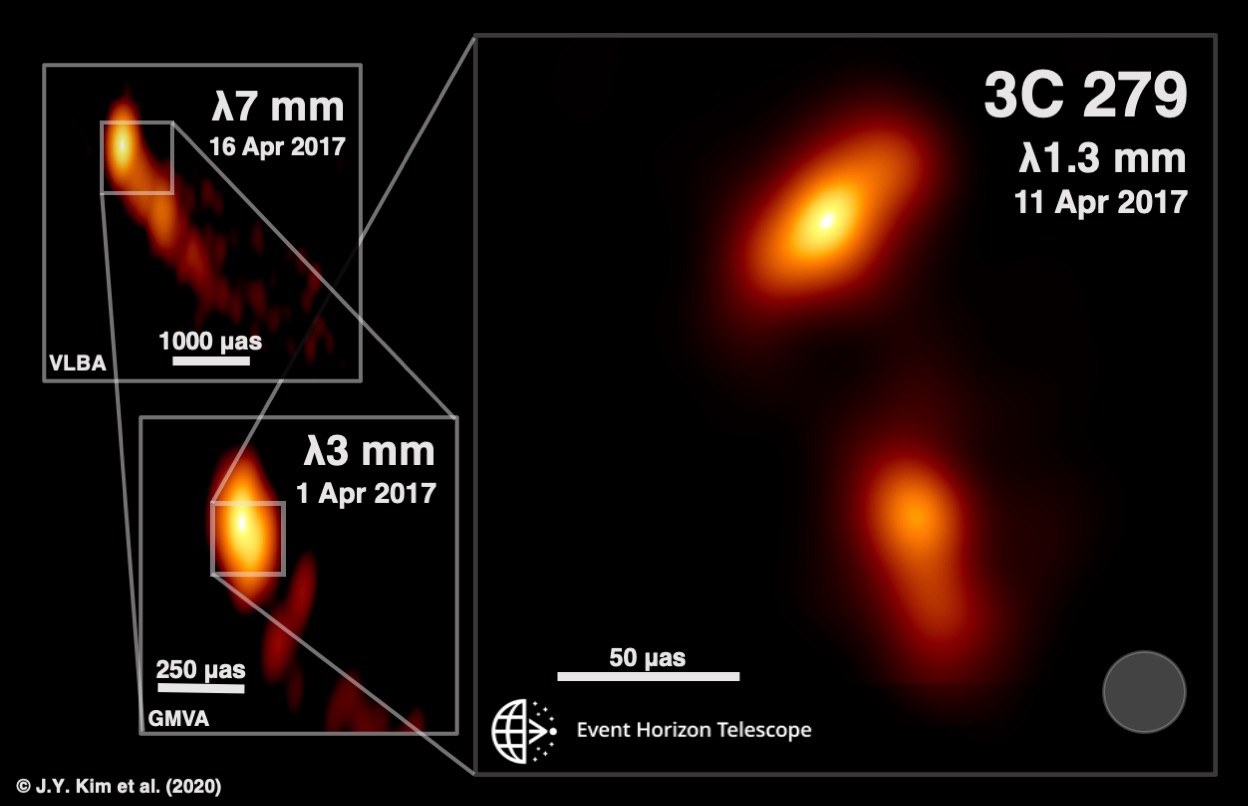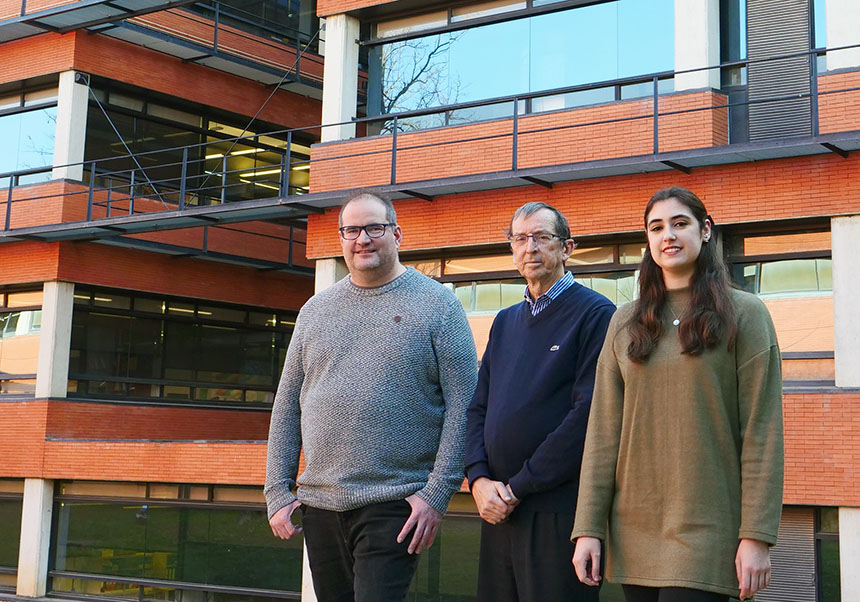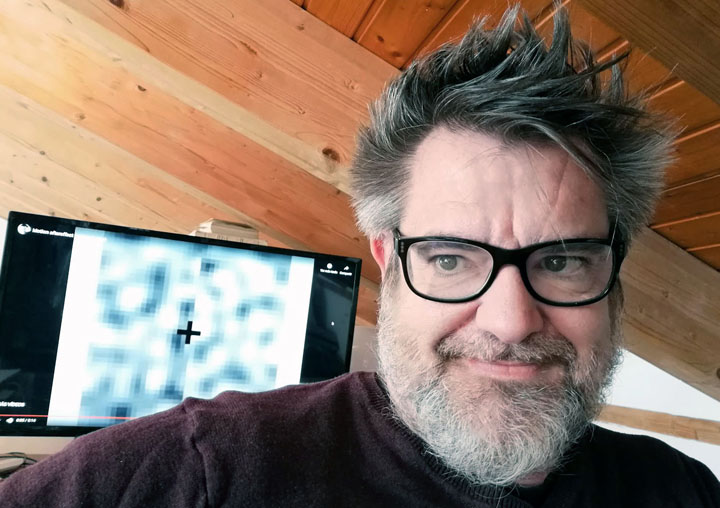The Event Horizon Telescope (EHT), that captured the first image of a Black hole, reveals unexpected structures in quasar 3C279
- Science Park
- April 7th, 2020

About a year ago, the Event Horizon Telescope (EHT) International Collaboration, in which the University of Valencia participates, published the first image of a black hole. Now the collaboration has observed in the finest detail ever a relativistic jet that is believed to originate from the vicinity of a supermassive black hole. The data, obtained using very long baseline interferometry (VLBI), help analyse the behaviour of nature in very extreme conditions. The results are published today in Astronomy & Astrophysics.
The Event Horizon Telescope (EHT) collaboration –the planetary scale radio telescope network that took the first image of a black hole last year– continues extracting information from the data collected in its global campaign in April 2017.
Target of these observations is quasar 3C279, a Galaxy of 5 billion light-years away –in the constellation Virgo– that scientists classify as a quasar because a point of light at its centre shines ultra-bright and flickers when as massive amounts of gases and stars fall into the giant black hole at its core; a black hole one billion times the mass of the Sun, that is, 200 more massive than our Galactic Centre black hole.
This black hole absorbs the gas and stars that come near into an inferred accretion disk, it shreds them and squirts some of it back out in two fine fire-hose-like jets, at speeds near the speed of light, from the vicinity of its event horizon, that border that surrounds the black hole and where space and time are infinitely deformed and stop working. Huge forces come into play in these regions that can only be studied by these objects, and it is impossible to reproduce these extreme space-time conditions on Earth.
The data now obtained by the linked EHT telescopes, and published today in Astronomy & Astrophysics, show the phenomenon with a degree of clarity never reached for 3C279, and allow us to appreciate particularities of the jet and the disk in action, revealing unexpected details. On the one hand, the jet, which is supposed to be straight, adopts a twisted shape at its base, which suggests to the investigation different possibilities for the explanation of the phenomenon, related to the presence of another companion black hole or to space-dragging effects of the space-time, to give some examples. On the other hand, for the first time we see features perpendicular to the jet, which, according to scientists, could correspond to the area where these jets originate, which would provide information about the mysterious formation processes of the jets and open new paths to continue learning how nature behaves in these extreme scenarios.
Comparing the images over subsequent days, in addition, very subtle changes have been detected in the morphology of the image, which the research team interprets as related to the mechanism by which the jets are born from the accretion disk, which grinds and absorbs the material that will later emanate in a jet form.

“We have observed a scenario that until now we had only seen in computer simulations”, states Jae-Young Kim, lead researcher at the Max Planck Institute for Radio Astronomy in Bonn (Germany). “Here, where we expected to find the region where the jet forms, we find a surprising perpendicular structure, something so unexpected as opening the smallest Matryoshka doll and finding, almost at the end of the process, a very different shape. This is one more proof of the surprises that the Universe has in store for us every time we open a new window to observe it.”
“Over the past decades, VLBI observations of quasar 3C279 have allowed us to establish a physical model capable of explaining how these supermassive black holes can become the most energetic objects in the Universe, but a single EHT image has been enough to rethink many of our previous hypotheses, and in particular how jets are generated from the increase in matter around the central black hole”, says José Luis Gómez, researcher at the Institute of Astrophysics of Andalusia (CSIC) and member of the research team and one of the main authors of the article.
“At the moment we have several scenarios to explain these observations. In any case, the analysis of light polarisation in the EHT observations will help us to clarify these mysteries in the near future”, says Ivan Martí-Vidal, CIDEGENT researcher of the Valencian Government at the Astronomical Observatory and the Department of Astronomy of the University of Valencia.
THE ROLE OF THE UNIVERSITY OF VALENCIA
And this is where the University of Valencia will soon play one of its fundamental roles in the project. Iván Martí-Vidal is one of the two coordinators of the EHT polarimetry team, as well as being the main developer of two of the fundamental algorithms for the calibration of telescopes. “Thanks to the study of the polarisation in these observations, we will be able to know precisely the structure of the magnetic fields that are immersed in the vicinity of the event horizon”, says the scientist. “These magnetic fields are the key to understanding the jets’ formation mechanism. In this context, the contribution of the University of Valencia is being crucial.”
Another aspect in which the University has played an important role has been the contribution of the researcher Rebecca Azulay to observation from the PAM Veleta IRAM 30m Telescope, in Sierra Nevada (Granada), within the global EHT observation campaign. Rebecca Azulay –astronomer of the Astronomical Observatory and the Department of Astronomy and Astrophysics of the University of Valencia throughout the course of the observations, as well as of the Max Planck Institute for Radio Astronomy in Bonn (Germany) has contributed to obtaining data from Sierra Nevada, as well as the technical configuration of the radio telescope. “The IRAM 30-meter telescope in Sierra Nevada has provided decisive information for the reconstruction of the images obtained”, says Azulay. “This is because it was the only one in Europe that could participate in these observations, thus enabling the size of the interferometer necessary to obtain the resolution reached”, she concludes.
A GLOBAL SCALE TELESCOPE
The telescopes contributing to this result were ALMA, APEX, the IRAM 30-meter Telescope, the IRAM NOEMA Observatory (expected 2021), the Kitt Peak Telescope (expected 2021), the James Clerk Maxwell Telescope (JCMT), the Large Millimeter Telescope (LMT), the Submillimeter Array (SMA), the Submillimeter Telescope (SMT), the South Pole Telescope (SPT), and the Greenland Telescope (GLT, since 2018).
Supported by considerable international investment, the EHT links existing telescopes using novel systems -creating a new instrument with the highest angular resolving power that has yet been achieved.
The telescopes work together using a technique called very long baseline interferometry (VLBI), that synchronises facilities around the world and exploits the rotation of our planet to form one huge, Earth-size telescope. The VLBI technique allows the EHT to achieve a solution of 20 micro-arcseconds –equivalent to identifying an Orange on Earth as seen by an astronaut from the Moon. The data analysis to transform raw data to an image required specific computers (or correlators), hosted by the MPIfR in Bonn and the MIT Haystack Observatory.
“Last year we could present the first image of the shadow of the black hole. Now we see unexpected changes in the shape of the jet in 3C 279, and we are not done yet. We are working on the analysis of data from the centre of our Galaxy, in Sgr A*, and on other active galaxies such as Centaurus A, OJ 287, y NGC 1052. As told last year: this is just the beginning”, explains Anton Zensus, Director of the Max Planck Institute for Radio Astronomy and Chair of the EHT Collaboration Board.
The March/April 2020 observing campaign was cancelled due to the CoViD-19 global outbreak. “We will now devote our full concentration to completion of scientific publications from the 2017 data and dive into the analysis of data obtained with the enhanced EHT array in 2018. We are looking forward to observations with the EHT array expanded to eleven observatories in the spring of 2021”, concludes Michael Hecht, astronomer from the MIT/Haystack Observatory and EHT Deputy Project Director.
The EHT collaboration is made up of 290 researchers from 62 institutions around the world.
Animation showing a zoom into 3C 279 and the jet motions within one week.
Reference: J.Y. Kim, T.P. Krichbaum, et al.: Event Horizon Telescope imaging of the archetypal blazar 3C 279 at an extreme 20 microarcsecond resolution, in: Astronomy & Astrophysics (April 07, 2020)
https://doi.org/10.1051/0004-6361/202037493













